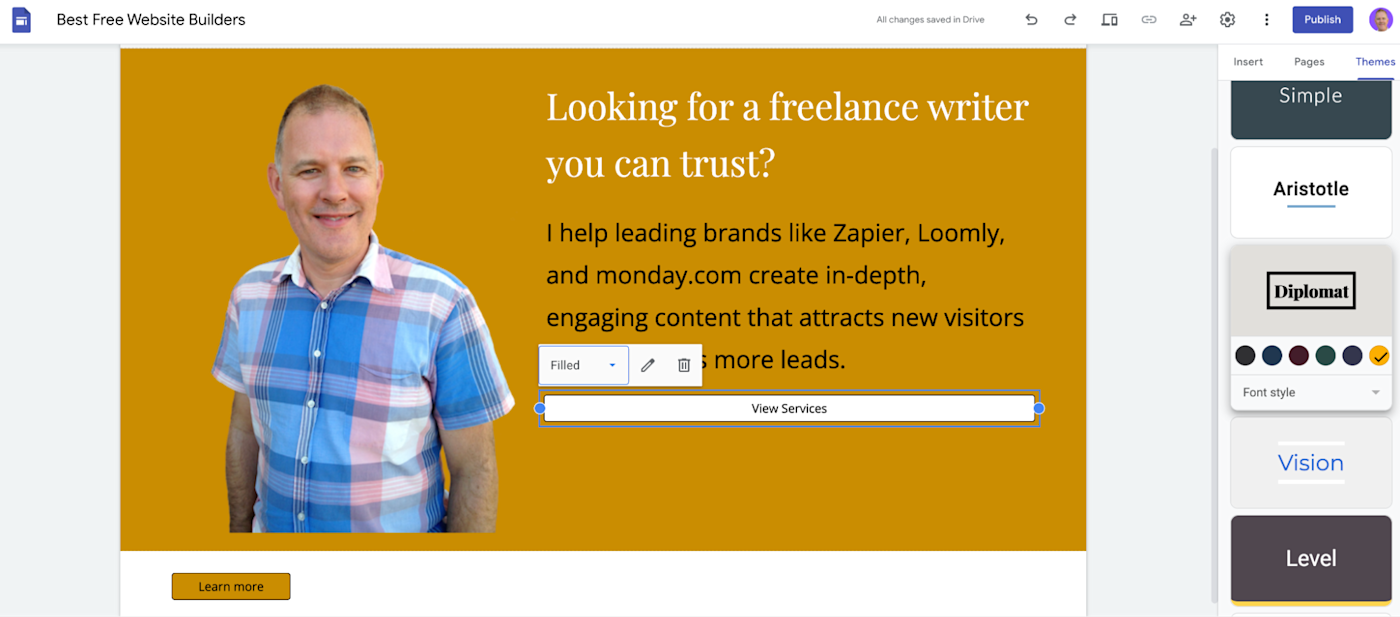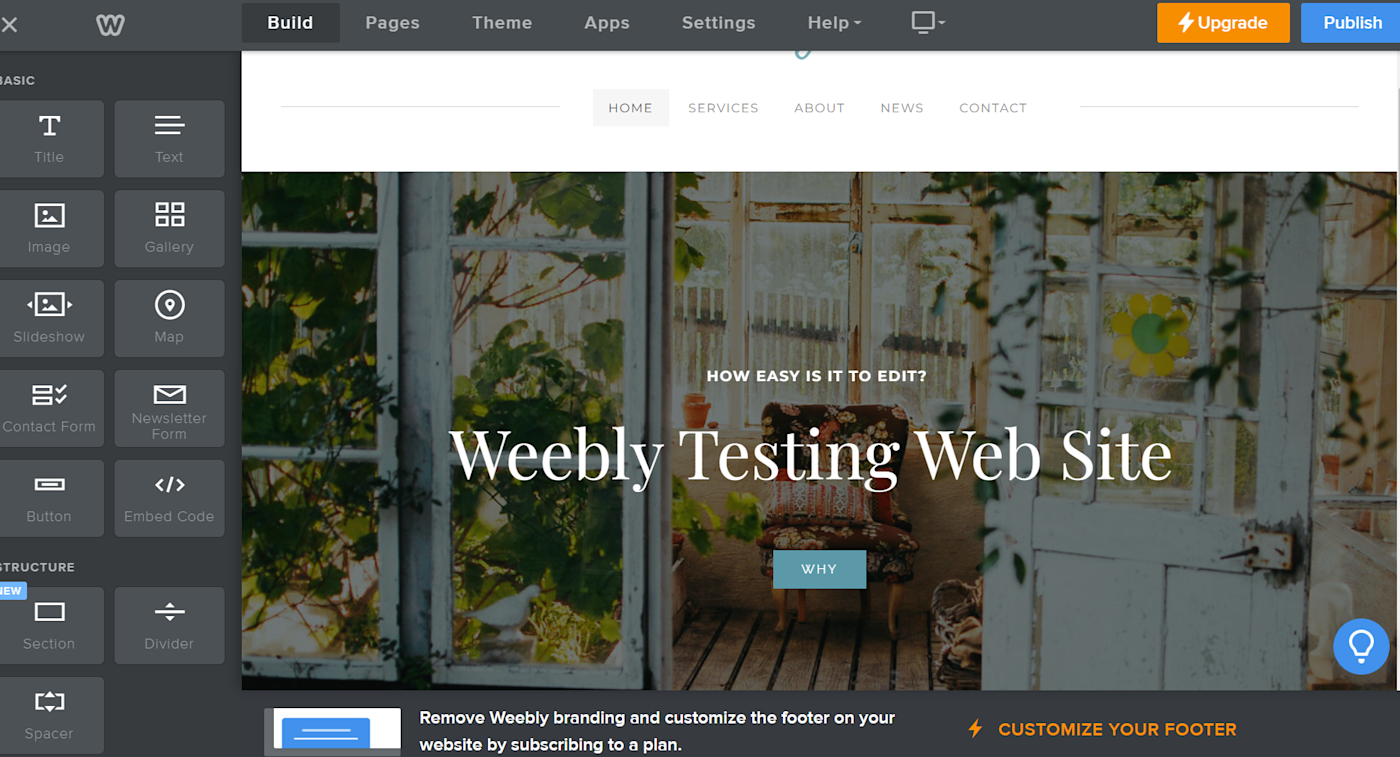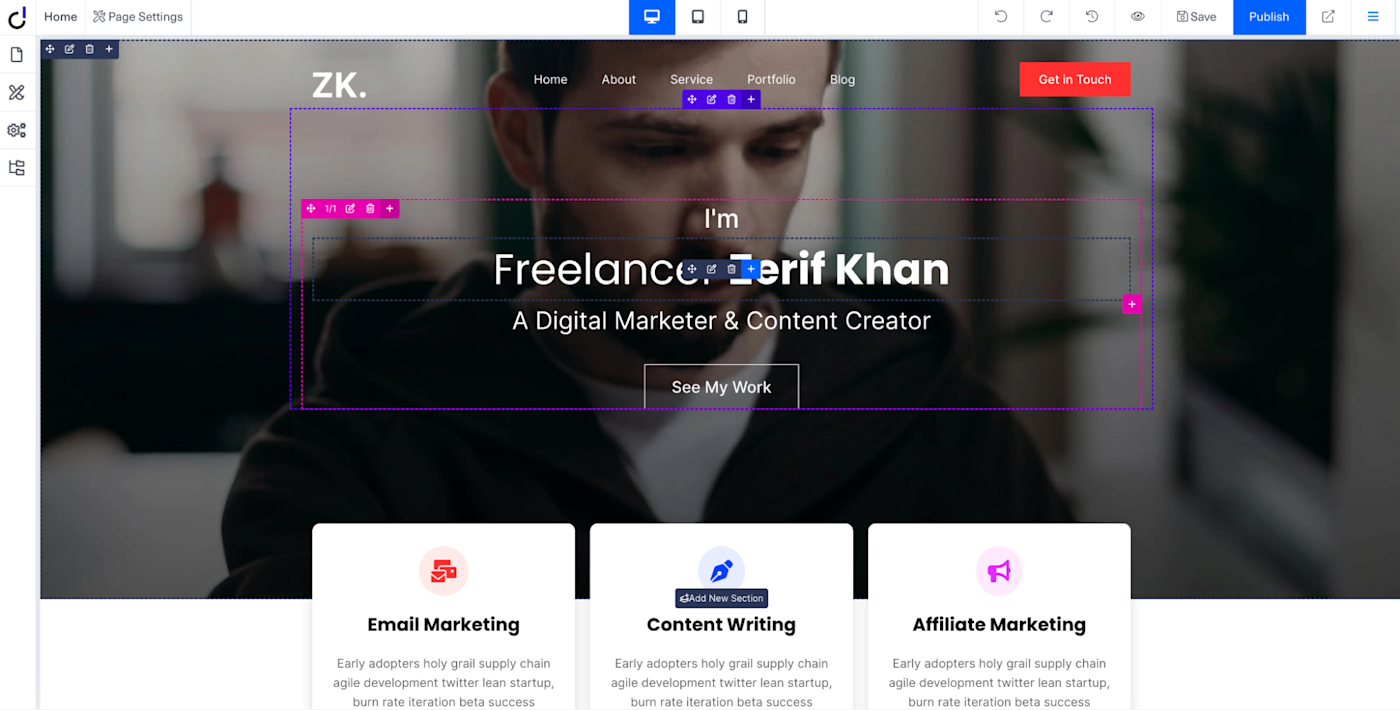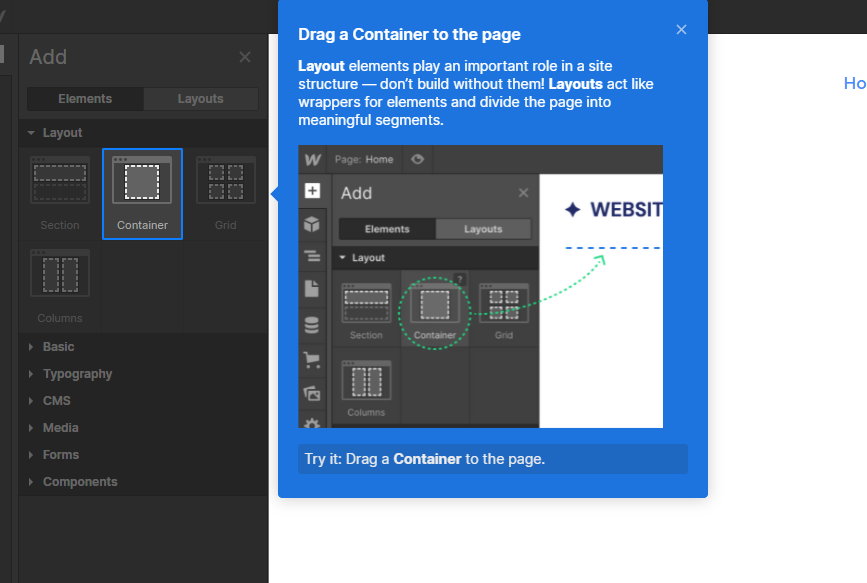7 best free website builders
If you want people to find you online, you need a website. But most smaller businesses don’t have the budget to hire an expert developer. That’s where free website builders come in: these tools make it easy to build a website for free.
These apps do the heavy lifting: you don’t need to know what CSS is or how to tinker with HTML. I spent a few weeks testing all the free website builders I could find, and these are the seven best.
The 7 best free website builders
- Google Sites for basic sites (without SEO)
- Weebly for simple, no-fuss websites
- GetResponse for email-focused businesses
- Wix for an all-around site builder
- Dorik for more experienced creators
- HubSpot CMS for growing businesses
- Webflow for advanced designers
What makes a great free website builder?
How we evaluate and test apps
All of our best apps roundups are written by humans who’ve spent much of their careers using, testing, and writing about software. We spend dozens of hours researching and testing apps, using each app as it’s intended to be used and evaluating it against the criteria we set for the category. We’re never paid for placement in our articles from any app or for links to any site—we value the trust readers put in us to offer authentic evaluations of the categories and apps we review. For more details on our process, read the full rundown of how we select apps to feature on the Zapier blog.
There are plenty of lists of the best free website builders, so what makes this one different? I didn’t just read customer reviews or the marketing materials for these website builders. I spent dozens of hours researching the best free site builders that users love—and then tested them myself.
I’ve always used WordPress to build sites for myself, so I was keen to see how these tools stacked up. For each one, I signed up and created a site from one of its templates—adding pages, adjusting copy, exploring SEO features, uploading my own images, and trying the various design elements.
Grow your business with marketing automation
I eliminated any website builders that were too hard to use or didn’t offer valuable free plans and then re-tested the remaining ones until I settled on the best of the best. Some are perfect for building basic sites with no design experience at all, while others are ideal for creating commercial sites but have a steeper learning curve.
As I was testing, I was focusing on the following criteria:
- Ease of use. Is the website builder easy to use, or do you need to be a junior dev to add a form? All the site builders on this list will be relatively easy for most users. I’ve mentioned which ones are newbie-friendly and which are better for those with more design experience. None require coding knowledge, but some do let you access the code.
- Customization options. Not all of us want a one-page website. I assessed how easy each builder is to customize, including the number of templates, if they offer drag-and-drop features, and whether you can adjust styles, colors, and elements. If there’s a trade-off between ease of use and customization, I’ve tried to make that clear.
- SEO tools. Building a site is just half the battle—you also need to rank on search engines. I looked at the SEO tools each website builder offers, such as the ability to adjust page titles and meta descriptions, add alt tags, and upload a site map.
- Value of free plans. Is the free plan really free, or does the builder ask you to upgrade every time you make a change? I made sure I was only looking at truly free options. Of course, there will always be features you’ll need to upgrade for, but all of these tools let you launch a website for free.
- Primarily a website builder. Some website builders are actually another tool with website-building capabilities. Although some of these tools are part of a suite of other marketing tools, they can all operate independently.
A quick note on domains: Most free website builders come with an ugly-looking free domain—like azaharmedia.hubspotpagebuilder.com—but allow you to purchase or add a custom domain. In my experience, I’ve always found it preferable to buy a domain independently on a site like Namecheap. This gives you more flexibility if you decide to move from one platform to another; e.g., if you purchased a domain on Weebly and wanted to move to Webflow, it could be more problematic.
Best free website builder for basic sites (without SEO)
Google Sites

Google Sites is a basic site builder with limited customization options and zero SEO tools. That’s fine if you’re a beginner or just want to test the waters, but don’t expect to conquer the search engine results.
You can choose from a dozen templates or a blank canvas to get started. And then refine the look-and-feel (style, color, and fonts) with a choice of six themes, or again, create your own. If you choose a standard theme, you’re limited to what you can edit. For example, if you want an orange button, you have to change the theme color, which may impact other color settings. And you can’t change the button size––everything is predefined. If you want to bypass the restrictions, you’ll have to create a custom theme.
That said, Google Sites is easy to use. In many respects, it’s like using Google Docs: everything gets saved to your Google Drive before you publish your site, and you can share it with collaborators. I did find it strange that there were no SEO settings, but you can set a custom path for each page. (Maybe you have to trust Google will handle the SEO, but all the same…)
- Google Sites pricing: 100% free; no paid plans.
- Ease of use: Easy to use. Similar to using Google Docs.
- Customization options: Limited. Choose from 12 templates and 6 themes for the look-and-feel of your site. Ideal for someone who doesn’t have a ton of website experience.
- SEO tools: Non-existent, surprisingly.
- Value of free plan: Limited. Suitable for beginners, hobbyists, or dabblers, but not as good as Weebly or Wix.
Best free website builder for simple, no-fuss websites
Weebly

Weebly is Square’s free, more limited website builder. It’s ideal for simple websites, like a portfolio or blog—but you can’t do things like sell online or easily connect it to your social media accounts.
When you sign up, you’ll be presented with a page asking if you want Weebly (personal websites) or Square Online (business websites). If you choose the personal option, you’ll get the bare bones you need with a really easy-to-use builder.
Just choose a template, then select different elements to edit. Each theme comes filled with text boxes, images, and named pages. And all of it is adjustable: you can edit everything with a click. Pictures are particularly easy to edit—you can even crop, adjust lighting, and add text right in the editor.
There aren’t as many templates as you’ll find in a tool like Wix, but the ones there are well-designed. You can add buttons, contact forms, and slide shows, swap out images, insert a newsletter form, and add a map, all with the click of a button. Or you can use the Apps tab if you want to add additional features like Google Ads or forms. Most cost a few bucks, but they aren’t subscriptions, which is nice.
Your site also comes with SSL enabled, which is good for SEO, and Weebly makes it easy to change your favicon, the icon that appears in the browser tab for your website. If you want to view a mobile version of your site, just click the mobile icon in the top navigation. Under the SEO tab, you can add a page title, URL, description, meta keywords, and custom header/footer code, like Google Analytics tracking codes.
If you choose the free plan, your site will have Weebly branding and domain—standard for free site builders. The paid plans aren’t a great deal: just to connect a custom domain is $10/month. So if you need more than this tool offers, I’d opt for one of the next tools on the list.
- Weebly pricing: Free plan available; paid plans start at $10/month.
- Ease of use: Very intuitive. If you want to change something, just click on it.
- Customization options: Not as customizable as other platforms, like Wix, but that makes it ideal for someone who doesn’t have a ton of website experience.
- SEO tools: Very basic, but better than some site builders that offer almost nothing.
- Value of free plan: Decent, but not outstanding.
Webnode is a good Weebly alternative. You can choose from over a hundred templates and use the drag-and-drop editor to move elements around. The clean interface is friendly to use, and unlike other site builders, there’s no sidebar to overwhelm you. If you want to edit something, just click on it and make changes. It was a close call, but Webnode didn’t make the cut because it’s not quite as intuitive as Weebly.
Best free website builder for email-focused businesses
GetResponse

Most of the free site builders on this list are standalone platforms. That’s because every tool out there seems to offer a free site builder—but most are terrible. You can throw together a half-decent site, but it won’t scale with you and probably won’t have the features you need.
But GetResponse—which is a more generalized marketing tool with a focus on email—offers a free site builder that’s pretty impressive. Start by telling it how you want to build your site, choosing a template or using the AI-powered builder. I chose a business template, and it was easy to change all the basic elements like font, size, and images and introduce new sections, such as testimonials. For example, you can change the button shape, size, and alignment and then get into advanced settings, like shadow effects, border styles, and colors. You can even hide page elements on a mobile device with the click of a button.
I was impressed by the features, and it didn’t feel overwhelming at all. I didn’t have to search for things—just clicked to edit, and everything I needed was right there.
Oddly, on the marketing side, the tool is pretty bare-bones. You can easily optimize for mobile (there’s a whole tab for it), but SEO features are somewhat limited: you can adjust the meta title and description, but that’s about it. You can also add custom code, like HTML, CSS, or JavaScript, in the page header element. Still, GetResponse is a strong contender for a free site builder, especially if you already use it for your email marketing or plan to focus on email marketing.
Want to do more with GetResponse? Connect it to Zapier to automatically add Facebook lead ads leads or PayPal customers to your GetResponse email list—and more.
Add new Facebook Lead Ads leads to GetResponse as new contacts
Facebook Lead Ads, GetResponse
Facebook Lead Ads + GetResponseMore details
Create New GetResponse Contacts from PayPal Sales
PayPal, GetResponse
PayPal + GetResponseMore details
- GetResponse pricing: Free plan available; paid plans start at $15.58/month.
- Ease of use: Very intuitive, especially for how much you can adjust.
- Customization options: GetResponse offers hundreds of templates and easy drag-and-drop features in the templates.
- SEO tools: Limited but sufficient. You can edit meta and alt tags and optimize for mobile.
- Value of free plan: Great. You can build and launch a site, add your own domain, and manage up to 500 newsletter contacts—all for free.
Best free all-around website builder
Wix

Wix is one of the most popular drag-and-drop website builders on the market—but is it worth the hype? If you’re looking to build a straightforward website with a few features, and don’t want to get bogged down in decisions, Wix is a solid choice.
Start by telling Wix what type of site you want, and any additional features you need, such as a blog, chat, forms, or an online store. Next, you can pick a template from over 900 designs, all broken down by type. They all look professional and can be easily adjusted to fit your needs. Or, you can let Wix create your site using the Wix ADI feature. I tried both options but was underwhelmed by the automatic Wix ADI results.
If you choose a template, it loads slowly the first time as it populates information: it took a little over 10 seconds to load the template I chose. But once you get into the template to edit, you’ll see why—it’s a seriously robust editor for a free website builder. To build your desired site, you can change fonts, add headings, include lists, and even drag and drop sections. No coding, no flipping through tabs. I found it quite intuitive to use (though I have used WordPress site builders for years).
Wix also offers tons of integrations, including email, so you can easily launch a digital marketing campaign right from your Wix dashboard. I was honestly amazed by the amount you can do for free. (Note: You can choose free images from Wix and Unsplash, or upload your own. But some of the available images are from Shutterstock, which you have to pay for.)
Not a copywriter? I am, but I know it’s easy to get stuck writing copy for your website. Wix suggests text, which is pretty awesome. Just tell the AI Text Creator what you want to say, and it’ll suggest how to make it sound good.
Wix also offers detailed SEO features to help you rank on Google; it won’t replace hiring an SEO expert, but it’s a good leg up. You can even create a marketing calendar and manage ads right inside Wix. That’s perfect for business owners who don’t have the time or energy to learn a whole host of different platforms.
Once you’ve added pages, updated your copy, and made whatever other adjustments you like, it’s time to make your site live. For a free site, you’ll get a domain ending with “.wixsite.com”—e.g., azaharmedia.wixsite.co—and a Wix logo (pretty standard for free site builders). Of course, if you have your own domain, you can connect it.
As an added bonus, Wix integrates with Zapier, allowing you to add tasks to your project management tool or send email campaigns based on triggered automations in Wix.
Create cards in Trello when new automations are triggered in Wix
Wix, Trello
Wix + TrelloMore details
Send Mailchimp campaign drafts when a new Wix Blog post is published
Wix, Mailchimp
Wix + MailchimpMore details
- Wix pricing: Free plan available; paid plans start at $14/month.
- Ease of use: Easy-to-use drag-and-drop editor. I found it intuitive, but beginners might get overwhelmed; if so, they also offer a free AI website builder option called Wix ADI.
- Customization options: Very customizable—you can add forms, a blog, eCommerce features, and even create custom videos.
- SEO features: Quite a few! Wix also does a good job of explaining what each feature does and walks you through each process, even for off-site tools like Google Analytics.
- Value of free plan: Excellent. While some builders try to make you upgrade on every other feature, Wix includes most features to some degree with the free plan.
Read our comparison of Wix vs. Weebly for more details.
Best free website builder for more experienced creators
Dorik

Dorik lets you build a fully-fledged website or a single landing page for free and includes premium options if you want to add a blog or a paid membership.
Based on my experience of using WordPress page builders, I found it both intuitive and refreshing to use. Beginners may find it more challenging, but it’s easy to access the excellent online documentation.
You can start from scratch, import JSON, or preview and select one of the 39 website templates. When you first edit, Dorik walks you through the various settings. Essentially, you use the visual drag-and-drop editor to build sections, using 250+ UI blocks (rows and columns) and 20+ elements (text, buttons, icons, etc.) You can position the editor control panel on the left or right side of the screen.
There are a couple of neat editing features worth highlighting. First, there are color differentiators, so you know what you’re editing (for example, rows in a purple dashed line and columns in a pink dashed line). Second, there’s a Navigation Tree to pinpoint the precise rows to edit. With some site builders, it’s easy to mistake the wrong block or element.
The SEO settings are easily accessible and configurable for each page, from basics like title and description to advanced meta settings like FAQ schema and analytics. Dorik also lets you design for desktop, tablet, and mobile screen sizes if you want to adjust layouts accordingly.
- Dorik pricing: Free plan available; paid plans start at $79/year.
- Ease of use: Easy to use drag-and-drop editor. Beginners may get overwhelmed, but there’s good online documentation to hand.
- Customization options: Countless choices. Select from 39 templates, 250+ UI blocks, and 20+ elements to create your site.
- SEO tools: Full range including page title and description, no-index/no-follow meta settings, canonical URL, schema, and custom header/footer code.
- Value of free plan: Excellent. Includes unlimited page views, storage, premium templates and blocks, free SSL (HTTPS) certificate, global CDN (to load images faster), image optimization, SEO settings, and integrations.
Best free website builder for growing businesses
HubSpot CMS Hub

HubSpot is a popular business software platform for marketing, sales, and service teams, and its free website builder continues in the same vein. I loved the step-by-step plan that guides you through building your website, with percentages on how far along you are.
Start by selecting a theme for your site—you want page templates, modules, and style settings that fit your brand. The marketplace has hundreds (both free and premium) to choose from; I went with the Growth Theme.
Next, customize your theme’s settings (colors, fonts, and layouts) to fit your brand. For example, you can modify an existing color scheme or create your own. Then start building your site by setting up the popular pages—home, about, contact, and so on—and choosing a standard header and footer layout. HubSpot even provides a full tutorial on using the drag-and-drop editor. All together, you can choose from 47 modules (elements), including header, text, image, accordion, and CTA.
You can tell HubSpot CMS is geared towards business sites with its emphasis on creating a blog and robust SEO tools. There’s a dedicated setup step to create your blog title, URL, and description so it looks right in the search engines before you even publish individual posts. Then there’s a whole raft of general on-page SEO settings to enter, including title, description, URL (and canonical URL), language, featured image, and additional header and footer code snippets. HubSpot also provides SEO recommendations as you add content to your page and highlights what you need to address. HubSpot is all about inbound marketing, so you’ll definitely feel like you’re in safe hands. Just be sure to address the ugly default URL (yoursite.hubspotpagebuilder.com) with a custom domain.
And if you use HubSpot for more than just website-building, you can connect it to Zapier to automate all your workflows and put more resources back into your business. Here are some examples of how you can send form submissions where you need them.
Save new HubSpot form submissions to Google Sheets rows
HubSpot, Google Sheets
HubSpot + Google SheetsMore details
Send new HubSpot form submissions an email from Gmail
HubSpot, Gmail
HubSpot + GmailMore details
- HubSpot CMS pricing: Free plan available; paid plans start at $23/month.
- Ease of use: Easy to use. Smooth operation. Guided prompts.
- Customization options: Select from hundreds of free and premium templates and 47 modules (elements) to build a site that fits your brand style.
- SEO tools: Get SEO recommendations as you create content on pages. Customize further by adding code snippets to header/footer and defining a canonical URL.
- Value of free plan: Great free plan to get started. You probably want to upgrade to a premium plan to remove the HubSpot logo and use a custom domain with a more manageable and memorable URL.
Best free WordPress alternative for advanced designers
Webflow

Recently, I noticed more sites choosing Webflow over WordPress, so I was especially interested in trying it.
Some of the free site builders on this list are super easy to use, with hundreds of templates and drag-and-drop editors. That’s not Webflow. Once you create an account, Webflow asks who you are (marketer, website builder, etc.) and if you have experience with CSS/HTML. This is a great way for them to create a platform that’s easier for everyone to use—but it seemed to fall short. I tried creating a second account and said I was building a site for myself with no coding experience…and the onboarding was the same.
They have a few free templates, or you can purchase one that makes your site easier to build (similar to WordPress). Plus, they offer an optional walk-through (and email tutorials) to familiarize you with the platform, which is quite helpful. If you’re comfortable with WordPress and the concept of styles and classes, you should be ok. But if you’re new to website builders, it might be hard to get your footing.
But there’s a reason for that: there are a lot of features and a ton of customization options. You can add containers, adjust the height, change fonts, add buttons, and on and on—center, stack containers horizontally, and much more.
If you know what to do with SEO, you’ll have access to everything you need, including title tags and meta descriptions. But they aren’t easy to find: for example, to add the meta description, you have to navigate to the main page panel, click on the page, click settings, and then finally, you’ll see SEO settings.
Another thing I love about Webflow—which also makes it a good WordPress alternative—is the ability to expand site functionality with integrations and widgets for targeting, limiting spam, engaging customers, managing your CRM, and much more. It’s not the easiest platform to use, but it’s incredibly powerful for a free site builder.
Using Zapier, you can connect your Webflow site to other apps you use. Send new Webflow form submissions to a spreadsheet or email marketing tool, or even send emails when someone fills out a Webflow form.
Send Webflow form data to Google Sheets
Webflow, Google Sheets
Webflow + Google SheetsMore details
Send emails via Gmail for new Webflow form submissions
Webflow, Gmail
Webflow + GmailMore details
- Webflow pricing: Free plan available; paid plans start at $14/month.
- Ease of use: Not easy for newbies. They do offer a walk-through, or you can use a template, but if you’re looking for an easy drag-and-drop builder, Webflow isn’t it. On the other hand, if you’re comfortable with a WordPress page builder like Elementor, you’ll be fine.
- Customization options: Tons of customization options, but you’re building the site almost from scratch.
- SEO tools: You can access everything you need, but they aren’t super obvious. Those who aren’t familiar with SEO may struggle.
- Value of free plan: The free plan gives you access to all features, up to 50 CMS items, 1 GB of bandwidth, and a Webflow.io domain.
Should you use a free website builder?
If you’re launching a 1,000+ page eCommerce store or building a fully interactive app, you probably want to hire a developer—or at least pay for a fully-loaded website builder. But if you’re just starting out or need to get your business online, these options will get the job done. Dorik and HubSpot CMS have both given me food for thought about whether I should migrate from WordPress. Which website builder will you choose?



